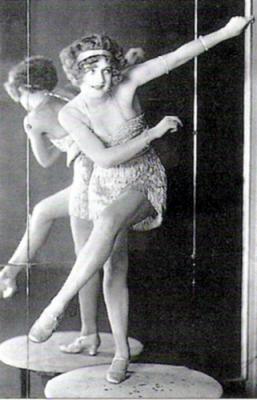I present here a quick timeline, via some films I have come across in my travels that illustrate the sorts of dances that were popular with the young'ns in the '10s, '20s and '30s. Most adults gave these up when they reached 25 or so, leaving the kicks and twirling skirts in favor of something a bit more sophisticated; but while they were young, those kids of the Jazz Age really knew how to cut a rug.
The thing that most distinguished "Youth Dances" from "Adult Dances", other than their relative athleticism, was not some fine point of technique or special step, it was the spirit of showing off. Adult dances were very pointedly not about showmanship. They were partner focused, and adult dancers almost never separated to do underarm turns or other showy moves. Kids on the other hand, were all about the showy moves, all about "Hey, look at me!". An adult dance was focused on the partner. A youth dance on the audience of peers.
 The connections between these dances are pretty clear, as they progressed in a parallel track with the more mainstream Foxtrot and other ballroom dances. In fact, I would assert that they are all really just different flavors the same dance. "Youth Dance" happened when kids started inventing energetic, showy moves and wiggling their bodies to jazzy music. The specific combinations of moves and style of wiggling evolved over time, but there really are no clean breaks, just a gradual evolution with new moves being added to the mix and old moves falling out of fashion. We have some convenient reference points we might call "Charleston" or "Collegiate" or "Shag" which are helpful today but, at the chaotic time of their invention, lacked the clear definitions, precise terminology and sense of orthodoxy we moderns so often want to impose on the dances of the past.
The connections between these dances are pretty clear, as they progressed in a parallel track with the more mainstream Foxtrot and other ballroom dances. In fact, I would assert that they are all really just different flavors the same dance. "Youth Dance" happened when kids started inventing energetic, showy moves and wiggling their bodies to jazzy music. The specific combinations of moves and style of wiggling evolved over time, but there really are no clean breaks, just a gradual evolution with new moves being added to the mix and old moves falling out of fashion. We have some convenient reference points we might call "Charleston" or "Collegiate" or "Shag" which are helpful today but, at the chaotic time of their invention, lacked the clear definitions, precise terminology and sense of orthodoxy we moderns so often want to impose on the dances of the past.
I will hit on just a few clear reference points that give a sense of the flow. This collection is nothing like comprehensive - and never could be since only a tiny fraction of what the kids of the Jazz Age were inventing ever found its way to film. Further, the vagaries of copyright limit what I can post here, so sadly, much of my best stuff will have to be reserved for one of my live presentations or classes.
I present these films with a minimum of commentary, and will mostly let them speak for themselves. In none of this will I try to instruct you in the fine points of any of these styles. Such an undertaking would be impossible in the space I have allocated to it. My main aim is to provide context and a sense of the historical flow. I hope you may, however, find much in the film clips that is worthy of emulation.
